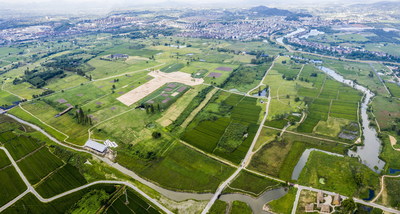HANGZHOU, China, July 10, 2019 /PRNewswire/ -- China's Archaeological Ruins of Liangzhu City, located in the eastern Chinese city of Hangzhou, was put on the United Nations Educational, Scientific and Cultural Organization's World Heritage List as a cultural site on July 6, according to Hangzhou Liangzhu Archaeological Site Administrative District Management Committee.

Liangzhu Ancient City Site Park
The decision to add the Chinese cultural site was supported by the World Heritage Committee members at its ongoing 43rd session in the Azerbaijani capital of Baku, as the site bears testimony to the over 5,000-year-long Chinese civilization and stands as an authentic and intact heritage.
With this new inscription, the World Heritage List now includes 55 properties across China. It's also the third world cultural heritage site in Hangzhou after the West Lake and the Beijing-Hangzhou Grand Canal.
The property testifies to the existence of a regional state with a unified belief system and supported economically by rice-cultivating agriculture in late Neolithic China, as well as the outstanding contribution to the Chinese civilization origin by the Yangze River region, according to the World Heritage Committee.
Located in the eastern foothills of the Tianmu Mountains in a plain crisscrossed by a network of rivers, the Liangzhu ruins were once the center of power and belief of an early regional state around the Taihu Lake.
In 1936, Shi Xingeng, a researcher with the West Lake Museum, carried out extensive surveys and excavations in Liangzhu on the outskirts of Hangzhou, capital of Zhejiang, where he discovered many prehistoric sites. The Liangzhu Culture was officially named in 1959.
Since the 1970s, the Liangzhu ruins have been excavated, researched and conserved through various archaeological efforts in Jiangsu, Shanghai and Zhejiang, enriching the Liangzhu Culture in terms of material life, settlement form, organizational structure, hierarchical differentiation, spiritual belief, etiquette system and civilization process. With the discovery of the Liangzhu City, a prehistoric ancient city that had remained missing for over 4,000 years surfaced in 2007.
In 2015, the discovery of a water project in Liangzhu that includes 11 dikes was announced. It is the oldest large water system ever found in China and one of the world's oldest dam systems.
The Liangzhu ruins with Liangzhu City as the core are the center of the Liangzhu civilization. The types of remains are rich and the site structure is complete, revealing the basic characteristics of the origin of the Chinese civilization and providing the most complete and important archaeological evidence for the over 5,000-year-long Chinese civilization. In particular, the Liangzhu City, which was built in the same period as ancient Egypt and Sumerian civilizations, is extremely rare in the world's similar sites in terms of scale and content, and is fair to be called "the first Chinese city".
"The importance of findings from the Neolithic Age in China has been greatly underestimated. Cong and bi unearthed from the Liangzhu historical site represent a unity of values in the region. The complexity of society in Liangzhu was on par with that of a country," according to Colin Renfrew, a retired professor of archaeology at the University of Cambridge and a fellow of the British Academy.
The Archaeological Ruins of Liangzhu City is presenting the far underestimated Neolithic Age in China to the world, telling about the civilization over 5,000 years ago and rewriting both the Chinese and global history.
Image Attachments Links:
![]() View original content to download multimedia:
View original content to download multimedia:
Previous: Chinese tourists to Cambodia exceed 1 million in 5 months
Next: Iran to implement visa-free regime for Chinese tourists from July 16